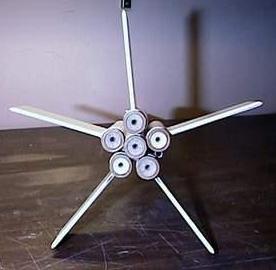Scratch 6-C Cluster Altitude Rocket Original Design / Scratch Built
Scratch - 6-C Cluster Altitude Rocket {Scratch}
Contributed by Bob Hvarven
| Manufacturer: | Scratch |
 Brief:
Brief:
A 6 "C" engine cluster altitude rocket from the May/June Issue of
Sport Rocketry Magazine. Found on page 26, titled "6-C Cluster Altitude
(Competition Rocketry)" By Dan Wolf.
Construction:
This is a very easy rocket to build from scratch. The alignment of the side
tubes is best accomplished using a line drawn on body tube for a guide. The
fins just need to be centered on the five side tubes and straight as any rocket
fin should be. The body tube, because of it's small diameter and length is
prone to bending during a hard landing. No special tools needed. I Used scrap
1/8 balsa for fins, and some Estes BT 20 tube I already had laying around. I
had to purchase some PNC 20 nose cones (short ones) as five are required for
the side tubes; I already had a regular PNC 20 for the nose.
Flight:
The recommended motors are 6 of the C6-7's. I used this combination on my first
flight. Normal preparations are used, i.e. wadding in body tube, careful
folding of parachute, etc. The motor tubes have no retention other than a tight
fit. Tape around motors as needed to insure a tight fit.
The flight was straight as an arrow, with no spinning or wobble. The large smoke trail was beautiful as was the flames from the 6 engines.
 A "Clip Whip" or a special set of
soldered igniters is needed to ignite all engines at once. I made a special set
of igniters soldered together. (worked perfectly)
A "Clip Whip" or a special set of
soldered igniters is needed to ignite all engines at once. I made a special set
of igniters soldered together. (worked perfectly)
I used a 1/8" elastic shock cord approx. 3 times the body length for the recovery. The 7 sec. delay is not long enough to get the most out of this rocket. It is still going up when the ejection occurs. The article discusses this, and an alternate method is to use a composite C10-10 for the center (body tube) engine for a longer delay before ejection. This also has draw-backs mentioned in the article.
Summary:
This is a specialty rocket for sure. It is a blast to launch and is very
impressive. It is an attention-getter by looks and flight performance. The 6
"C" motors give you approx. a F36 power range launch. This is a bunch
for such a light rocket and the performance shows it. It is a bit of a chore to
prep, and really doesn't lend itself to multiple launches during the day,
unless a good reliable "Clip Whip" is employed. The body tube is
prone to damage if recovery isn't exactly smooth.
Sponsored Ads
 |
 |











